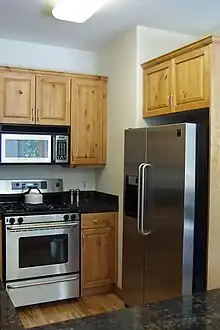Domestic technology
Domestic technology is the incorporation of applied science into the home. There are multiple aspects of domestic technology. On one level, there are home appliances, home automation and other devices commonly used in the home, such as clothes dryers and washing machines.

On another level, domestic technology recognizes the use of applied science to construct homes to achieve a particular goal, such as energy efficiency or self-sufficiency. For more information, read about self-sufficient homes. It has been claimed that domestic technology has led to decreases in the time people spend on household work, although the factual basis of this claim is disputed.[1]
Types of domestic technology
Many technologies are now routinely used around the home. For example, microwave ovens and washing machines,[2] among others.
Cleaning equipment
.jpg.webp)
Electric lighting
Cooking appliances
Food storage and preservation
Home maintenance
Air conditioning
Computer systems
- Data storage device
- Personal computer
- Telephone
- Video game console
- Knitting machine
- Plumbing
- Home router
Power generation
Home security
Home automation
In the 21st century, especially by the 2010s, home automation has increasingly[3] been introduced into the modern household, colloquially referred to as smart home technology.
While the technology was already in development in the 1990s,[4] only in the next two decades was local area networking ubiquitous in the home, thanks to the introduction of computer networking.
Since modern home networks often make use of wireless networking (e.g. Wi-Fi), modern automation can easily be set up without having to run wires through the building. Alternatively, they can be connected to wired networks.
Types of home automation

- Smart home appliances
- Automatic vacuum cleaners and other Domestic robots
- Smart locks
- Smart speakers, with voice controlled digital personal assistants.
Concerns towards home automation
Unlike older forms of domestic technology, smart appliances are Internet-facing, and there have been many concerns that cyberattacks may be conducted on insecure home appliances. A kind of attack is to deploy malware on smart home appliances known as botnets, which can be controlled by a remote attacker.[5]
References
- Bittman, Michael; Rice, James Mahmud; Wajcman, Judy (2004). "Appliances and their impact: The ownership of domestic technology and time spent on household work". British Journal of Sociology. 55 (3): 401–423. doi:10.1111/j.1468-4446.2004.00026.x. hdl:1959.4/34267. PMID 15383094.
- "New technologies in washing machine smartphone Apps". Edmonton Maple Leaf Appliance Repair. 7 March 2022. Retrieved 24 March 2022.
- "The Rise of the Smart Home, Apartment or Condominium".
- "The History of Smart Homes".
- "IoT botnets: Smart homes ripe for a new type of cyberattack".
Further reading
- Cowan, Ruth Schwartz. More Work for Mother: The Ironies of Household Technology from the Open Hearth to the Microwave (Basic Books, 1983) ISBN 0-465-04731-9.
- Habib, Laurence. Computers and the Family: A Study of Technology in the Domestic Sphere. PhD Thesis, London, UK: London School of Economics and Political Sciences (LSE) 2000 (PDF file).
- Siddiqui, Shakeel, and Darach Turley (2006). "Media technologies: Mediated families" In: Gavan Fitzsimons and Vicki Morwitz ed. Advances in Consumer Research, Vol. 34, Association for Consumer Research: Orlando.
External links
- ICS 97.040.30 Domestic refrigerating appliances Archived 28 February 2007 at the Wayback Machine
- Plan website